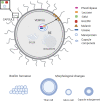Cryptococcus spp. and Cryptococcosis: focusing on the infection in Brazil
- PMID: 35486354
- PMCID: PMC9433474
- DOI: 10.1007/s42770-022-00744-y
Cryptococcus spp. and Cryptococcosis: focusing on the infection in Brazil
Abstract
Cryptococcosis is a global fungal infection caused by the Cryptococcus neoformans/Cryptococcus gattii yeast complex. This infection is acquired by inhalation of propagules such as basidiospores or dry yeast, initially causing lung infections with the possibility of progressing to the meninges. This infection mainly affects immunocompromised HIV and transplant patients; however, immunocompetent patients can also be affected. This review proposes to evaluate cryptococcosis focusing on studies of this mycosis in Brazilian territory; moreover, recent advances in the understanding of its virulence mechanism, animal models in research are also assessed. For this, literature review as realized in PubMed, Scielo, and Brazilian legislation. In Brazil, cryptococcosis has been identified as one of the most lethal fungal infections among HIV patients and C. neoformans VNI and C. gattii VGII are the most prevalent genotypes. Moreover, different clinical settings published in Brazil were described. As in other countries, cryptococcosis is difficult to treat due to a limited therapeutic arsenal, which is highly toxic and costly. The presence of a polysaccharide capsule, thermo-tolerance, production of melanin, biofilm formation, mechanisms for iron use, and morphological alterations is an important virulence mechanism of these yeasts. The introduction of cryptococcosis as a compulsory notification disease could improve data regarding incidence and help in the management of these infections.
Keywords: Antifungal treatment; Cryptococcosis; Epidemiology; Virulence mechanism.
© 2022. The Author(s) under exclusive licence to Sociedade Brasileira de Microbiologia.
Conflict of interest statement
The authors declare that they have no conflict of interest.
Figures
References
-
- Júnior JL LV, Júnior P, Nicola AM, Santos M (2017) Implementation of the Brazil Cryptococcosis network in the federal district - RCB-DF. J Med Health Brasília 6(2):151–3:2238–5339
Publication types
MeSH terms
Grants and funding
LinkOut - more resources
Full Text Sources
Medical
Research Materials
Miscellaneous


